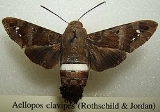
Aellopos clavipes
Encyclopedia
Aellopos clavipes, also known as the Clavipes Sphinx, is a moth
of the Sphingidae
family. It lives mainly in Central America
but ranges from Venezuela
to California
, Arizona
, and Texas
in the United States
.
The body is dark brown with a wide white band across the abdomen. The wings are dark brown. The forewing has a black cell spot and three white spots near the pale brown marginal area.
Adults are on wing from May to December in Costa Rica. There are probably three main generations with adults on wing in December, from April to May and in September.
The larvae feed on various Rubiaceae
species, including Randia rhagocarpa, Randia monantha, Randia aculeata
, Guettarda macrosperma and Genipa americana
. Pupation takes place in shallow underground chambers.
Moth
A moth is an insect closely related to the butterfly, both being of the order Lepidoptera. Moths form the majority of this order; there are thought to be 150,000 to 250,000 different species of moth , with thousands of species yet to be described...
of the Sphingidae
Sphingidae
Sphingidae is a family of moths , commonly known as hawk moths, sphinx moths and hornworms, that includes about 1,200 species . It is best represented in the tropics but there are species in every region . They are moderate to large in size and are distinguished among moths for their rapid,...
family. It lives mainly in Central America
Central America
Central America is the central geographic region of the Americas. It is the southernmost, isthmian portion of the North American continent, which connects with South America on the southeast. When considered part of the unified continental model, it is considered a subcontinent...
but ranges from Venezuela
Venezuela
Venezuela , officially called the Bolivarian Republic of Venezuela , is a tropical country on the northern coast of South America. It borders Colombia to the west, Guyana to the east, and Brazil to the south...
to California
California
California is a state located on the West Coast of the United States. It is by far the most populous U.S. state, and the third-largest by land area...
, Arizona
Arizona
Arizona ; is a state located in the southwestern region of the United States. It is also part of the western United States and the mountain west. The capital and largest city is Phoenix...
, and Texas
Texas
Texas is the second largest U.S. state by both area and population, and the largest state by area in the contiguous United States.The name, based on the Caddo word "Tejas" meaning "friends" or "allies", was applied by the Spanish to the Caddo themselves and to the region of their settlement in...
in the United States
United States
The United States of America is a federal constitutional republic comprising fifty states and a federal district...
.
The body is dark brown with a wide white band across the abdomen. The wings are dark brown. The forewing has a black cell spot and three white spots near the pale brown marginal area.
Adults are on wing from May to December in Costa Rica. There are probably three main generations with adults on wing in December, from April to May and in September.
The larvae feed on various Rubiaceae
Rubiaceae
The Rubiaceae is a family of flowering plants, variously called the coffee family, madder family, or bedstraw family. The group contains many commonly known plants, including the economically important coffee , quinine , and gambier , and the horticulturally valuable madder , west indian jasmine ,...
species, including Randia rhagocarpa, Randia monantha, Randia aculeata
Randia aculeata
Randia aculeata, commonly known as white indigoberry or white indigo berry, is a species in the Rubiaceae. It is a shrub or small tree that grows from 2 to 6 m tall. R...
, Guettarda macrosperma and Genipa americana
Genipa americana
Genipa americana is a species of Genipa, native to northern South America , the Caribbean and southern Mexico, growing in rainforests. It is commonly called Genipapo or Huito; the alternate name Jagua may refer to other species of Genipa as well. To the Inca, it was known as hawa or wituq...
. Pupation takes place in shallow underground chambers.
Subspecies
- Aellopos clavipes clavipes
- Aellopos clavipes eumelas (Jordan, 1924) (Jamaica)
External links
- Clavipes Sphinx Butterflies and Moths of North America

